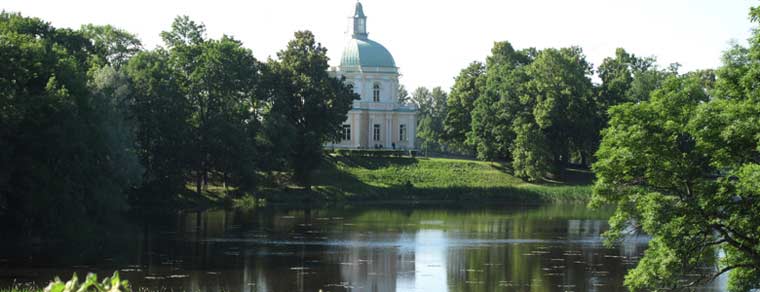
City of Lomonosov in the past the town Oranienbaum - today one of the most beautiful palaces and parks of around Petersburg, covers an area of about 170 hectares. Was originally the estate "uncrowned king" and close associate of Peter I of Alexander Menshikov.
Name manor translated from German as "orange tree» (orangen Baum). The initial draft of the estate Menshikov was Italian architect J.-M. Fontana, construction led JG Schadel employed in Germany. In the 1710s - 1720s in Oranienbaum magnificent ensemble was created, including the Grand Palace from the terraced garden. From the Gulf to the palace led canal, ending a small harbor. To the east of the palace was blocked river Karosta (Karasta) and created Lower Pond, was known as the Small Sea Pleasure (Pleasure is contained "flotilla" Menshikov).
Since the early 1740s belonged Oranienbaum nephew of Elizabeth Peter Fedorovich (Karl Peter Ulrich of Holstein-Gottorp), declared heir to the throne, and in 1826 was acquired by Grand Duke Mikhail Pavlovich and until the revolution belonged to his descendants - the dukes of Mecklenburg-Strelitz.
The Grand Palace
Open: from 11.00 to 16.00, days off - Tuesday and last Monday of each month. (7-812-422-3753,423-1637)
The Grand Palace - a large building, which stands on the edge of the fortified terrace, facing front facade (length 210 m) to the gulf. To the main building to the west and east, adjacent one-story arched gallery, completed domed pavilions - West (the Church) and the East (Japan).
Peterstadt
Peterstadt - "comic castle", built in the years 1756-1762 Rinaldi and M. Hoffman for heir Peter Fedorovich. Today the complex survived only wicket fortress and palace of Peter III - a miniature two-story building with six rooms, decorated in the rococo style. Personal Dacha Own ensemble giving Catherine II - rococo masterpiece - was created in 1760 - 1770 by architect A. Rinaldi. The basis of the ensemble put regular park to the west of the Grand Palace. On its southern border is the Chinese Palace, decorated inside with an amazing luxury. Chinese it was called because of the two rooms, decorated in the style of chinoiserie. Tessellations halls of the palace drawn from fifteen wood. Suspended "mirror" the ceilings and walls of buildings are decorated with gilded moldings and paintings. The ensemble also included Sliding Hill (1762-1774), from which a grand pavilion with interiors decorated with artificial marble.





